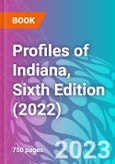In full color, this section gives the researcher a real sense of the nation’s 19th state and its history and includes a photo gallery, demographic maps, and comprehensive sections on Indiana’s government, land, and natural resources. With charts and maps, these 42 pages help to anchor the researcher to both physical and political aspects of the state.
Demographic Profiles
The careful layout gives the user an easy-to-read snapshot of every single place and county in Indiana, from the biggest metropolis to the smallest unincorporated hamlet. Each profile contains complete data sets on various topics such as History, Geography, Climate, Population, Vital Statistics, Economy, Income, Taxes, Education, Housing, Health & Environment, Public Safety, and more. The richness of each profile is astounding in its depth, all packed in an easy-to-navigate, compact format.
School District Data
Users will have immediate access to a snapshot profile of each district serving 1,500 or more students. This section begins with an Educational State Profile, summarizing number of schools, students, diplomas granted, and educational dollars spent. Following the state, profile is School District Rankings on 16 topics ranging from Teacher/Student Ratios to High School Drop-Out Rates. Following these rankings is statewide National Assessment of Educational Progress (NAEP) results and data from the Indiana Statewide Testing for Educational Progress-Plus (ISTEP+) - an overview of student performance by subject, including easy-to-read charts and graphs.
Hispanic, Asian & Ancestry Group Statistics
Here, users will find need-to-know data on the Hispanic and Asian population of each state, along with data on all ancestry groups reported. Details include population concentrations, income, educational attainment, and much more.
Detailed Weather Data
This section provides extensive climatological data on all of Indiana’s weather stations, including statistics on maximum and minimum temperatures, precipitation, extreme temperatures, humidity, and more.
Comparative Ranking Charts
Selected statistics are pulled for 100 of Indiana’s largest towns and cities. Each of 22 different data points has its own two-page spread with cities listed in alphabetical order, so researchers can easily compare and rank cities. Among the statistics selected for this section are: Employment, Income, Unemployment Rate, Population Characteristics, Taxes, Cost of Living, Education, Health Care, Public Safety, Air Quality, and more.
Community Rankings
This new section includes tables that rank the top and bottom 150 communities with population of over 2,500, in dozens of categories.








